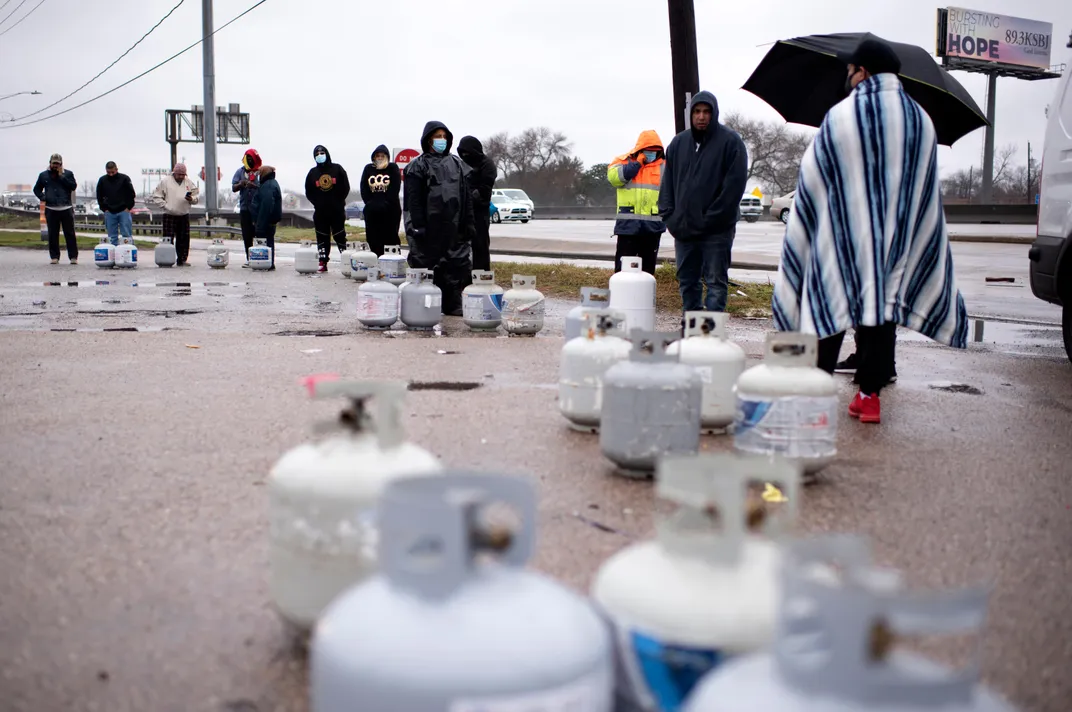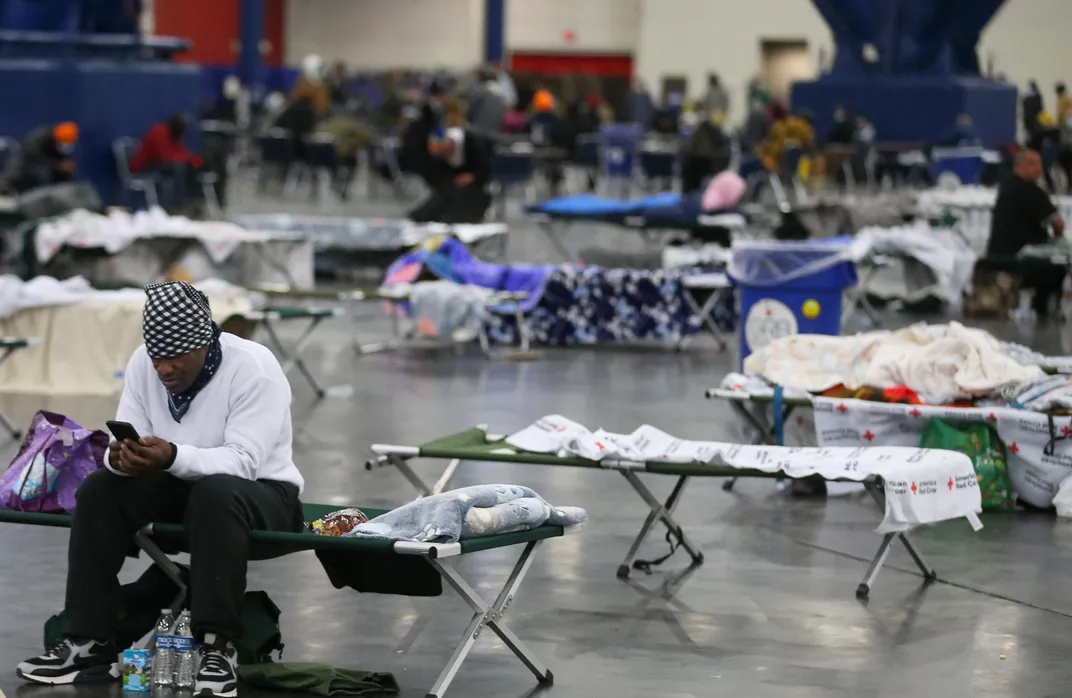How Winter Storm Uri Impacted the United States
The Arctic blast has swept across the Lower 48, bringing record cold temperatures and interruptions to electricity and water services
/https://tf-cmsv2-smithsonianmag-media.s3.amazonaws.com/filer/cb/b2/cbb284b9-73f5-4475-9e39-3be7fdd5baae/gettyimages-1231205316.jpg)
This week, an arctic blast brought frigid air from the North Pole across the United States. Winter storm Uri swept from the Pacific Northwest across the Central U.S., including states unaccustomed to severe winter conditions, before exiting the East coast late on Tuesday, Weather.com reports.
Record snowfall and low temperatures have interrupted services like heat, electricity and water for millions of people living in southern states that lack cold-weather infrastructure and snow removal mechanisms. As of Wednesday, CBS News’ Janet Shamlian reports that at least 24 deaths have been attributed to the winter weather. Texas has been especially hard-hit, in part because of its isolated electrical grid, Umair Irfan writes for Vox. About 12 million people in Texas are now under advisories to boil water before drinking it, Alex Samuels reports for the Texas Tribune.
Winter storm, Viola, is brought even more snow and cold weather to a stretch of the U.S. between Boston and central Texas, finally winding down Friday morning.

Record Snow and Low Temperatures
On February 16, just over 73 percent of the lower 48 United States was blanketed in snow, which is the highest percentage since NOAA began tracking snow coverage in 2011. Record snowfall hit Salt Lake City, Detroit and several Texas cities including Austin, Abilene and San Angelo.
Extremely low temperatures also hit regions where people and infrastructure are not accustomed to dangerous cold. While Anchorage, Alaska faced lows of plus-20 degrees Fahrenheit, Kansas City saw lows of minus-ten degrees on Tuesday morning, reports the Washington Post.
The Arctic blast that moved across the U.S. this week originated in Siberia, Matthew Cappucci wrote for the Post on February 10. Normally, a fast-moving ring of air called a jet stream keeps the Arctic’s frigid air in place at the top of the globe, where it forms the polar vortex, Umair Irfan reports for Vox. But the warming climate weakens the jet stream, which allows it to bend. In some places, warm air pushes up toward the Arctic, and elsewhere, the polar vortex can flow south, in this case to the United States.
Confused about the #PolarVortex? Usually a strong jet stream confines Arctic air to the north, stabilized by a big difference in temperature between low and high latitudes. The smaller the difference in temperature, the more the wind belts meander (Via @RemoteLongitude & @NOAA) pic.twitter.com/GEpzwjw1dS
— UN Climate Change (@UNFCCC) February 15, 2021
There is controversy among climate researchers about whether extreme cold events like Winter Storm Uri will become more common or not as climate change continues. In one camp, scientists expect that warming temperatures will make the events less common. Others say that as warming weakens the jet stream, the polar vortex will become unstable more often, causing more of these cold spells at least in the short term, per Vox. Per the Washington Post, anomalies of warm weather outpace unusual cases of extreme cold at a rate of two- or three-to-one.
Scientists will continue to collect data and over time, will be better able to predict how winter weather will be affected by climate change. “It’s a matter of how soon that connection will become clear and how big that connection will be,” says Walt Meier to Vox.
Millions Without Electricity and Water
Over the course of the week, about four million people lost electricity across southern states. On Tuesday, about 3.5 million of those power outages were in Texas, per the New York Times. As of Thursday morning, more than 500,000 people in Texas still hadn’t gotten power back, according to the Post. Both Oklahoma and Texas declared a State of Emergency.
One reason that Texas has had such a difficult time handling the effects of the winter weather is that the state has its own power grid, almost entirely independent of the country’s eastern and western power grids. Almost every facet of its power generation was impacted by the cold weather: piles of coal froze, ice blocked natural gas pipelines, wind turbines became iced over, reports Vox. Nuclear power plants shut down because of weather-related issues with their feedwater systems, Mary de Luna and Amanda Drane report for the Houston Chronicle.

While the energy supply plummeted, people’s demand for electricity shot up as they tried to heat their homes. The Electric Reliability Council of Texas reported that the state hit a new winter peak demand record of 69,150 megawatts. The state began implementing rolling blackouts in order to ration its energy supply, but some people have been without power for several days in a row amid sub-zero temperatures, said the mayor of Mainsfield, Texas, Michael Evans to NPR’s Steve Inskeep.
The situation is compounded by a shortage of potable water. Since being unable to heat their homes, residents have left faucets dripping in order to prevent the pipes from freezing. Now, 12 million people are impacted by water disruptions and boil-water notices, per the Texas Tribune.
The state has asked people to stop dripping faucets in order to conserve water for hospitals and fire departments, which have also seen dangerous shortages. If pipes burst, the water to the building will need to be shut off entirely.
As Winter Storm Viola winds down, it remains unclear when people already impacted by both storms will see relief.